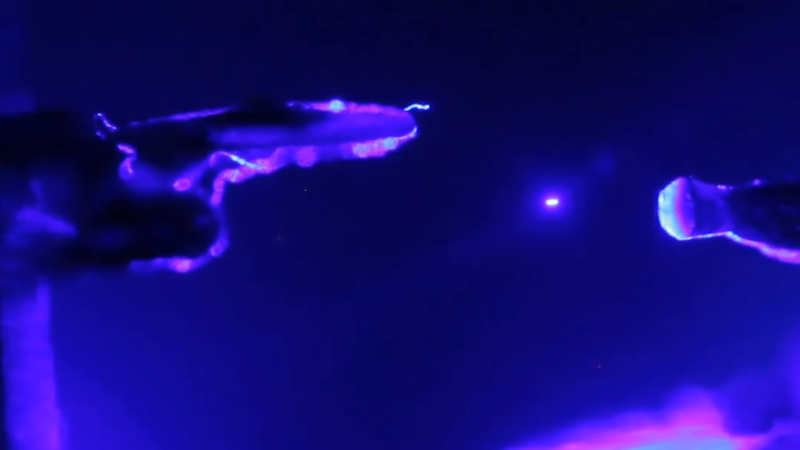You’ve seen it a million times in science fiction movies and TV shows: a moving holographic display. From Princess Leia asking for help to virtual tennis on Total Recall, it is a common enough idea. [Dan Smalley]’s team at BYU has made progress in projecting moving 3D images in thin air. While they might not be movie quality, they are a start, and, after all, you have to start somewhere.
The display traps a small particle in the air with a laser beam and then moves that particle around, leaving behind an illuminated path in the air. You can see the effect in the video below. The full paper explains how a type of ray tracing allows the relatively small optical trap display to appear larger and more fluid. While it does make images seem to appear behind the display’s actual volume, it also requires eye tracking to work since the illusion only works from a certain perspective.
These are not, of course, technically holograms. That’s actually an advantage in some cases because holograms require a tremendous amount of data that increases rapidly as the size of a display scales up. The optical trap display uses a much more manageable data rate.
We’ve seen optical trap displays before. In fact, volumetric displays seem to be all the rage lately.
















I found this a little disappointing. Essentially you use a high powered laser to position a particle that you light up with another laser. I don’t know what kind of power it takes to levitate a particle but I’m guessing it’s quite a lot, making the whole thing unsafe to view without special glasses to protect the viewer’s eyes. I can’t see how this would scale up to a practical size.
This paper doesn’t describe the experimental setup used, only the mathematical transformation that allows an increased effective display volume. But an earlier paper by the same author (https://doi.org/10.1038/nature25176) gives an idea of the parameters. The trapping beam is near-UV (405nm) so very low visibility compared to the RGB illuminating beams. They need around 24mW of 405nm light to reliably pick up and move the particle around.
I assume the beams are pointed in a direction transverse to the viewing direction but still… I wouldn’t want to look at it without eye protection.
I like the idea of using this tech along with cooled air holography ( Dosnt exist yet) essentially cooled air uses the mirage effect to change the refraction of particles of air, plus a warming effect (microwaves yay) in a humidified room to create stunning life like visuals. Unfortunately I was born poor so my black books are molding in a tent. I work all day for $20 an hour, single dad and yes I am on the spectrum. I went to college and was booted from science for proposing ideas using meta materials to visualize radiation measurements from afar ( now exists).
I’d love to hear your ideas, though I don’t have a background in engineering, I am an avid science and science fiction fan and try to make my fictional tech as grounded in real science as I can.
I find this really interesting. Especially the ‘optical trap’, being able to trap a particle and move it around with a laser. Probably the speed is still relatively slow, guessing that they use moving mirror technology. The next step would be to learn how to manipulate a laser without having to displace some mass.
Maybe this optical trapping could be done using streams of electrons, instead of light. Then the beam could be moved electromagnetically. I don’t think there is something like an ‘electron laser’ that emits electrons at a harmless speed?
Anyway, I followed your link ‘We’ve seen optical trap displays before’. However, that uses an *acoustic* trap system, so it’s not really the same.
The steering of the trap beam is done using a liquid-crystal based phase modulator. Essentially acting as a diffraction grating where you can change the grating period at will, which changes the angle of diffraction. The best ones at the moment have a rise time of a few milliseconds, so ~100Hz should be possible.
I think possibly the inertia and aerodynamic drag is the speed limiting factor here. Even if you can move the trap beam very fast, it doesn’t mean the trapped particle will follow! Optical traps have a relatively small holding force.
What about to try it in vacuum? Would it still have to deal with inertia and aerodynamics?
Put it in a box with reduced pressure inside. There’s a very long history of such “boxes” called CRTs.
Maybe use a bead of Aerogel? Lightest solid stuff known to man (as they say ;)). But it’s transparent, and to get enough light refracting from it, you might need to up the power of the laser to dangerous levels.
It should be possible to measure the influence of aerodynamic drag by trying it out in a vacuum chamber.
But, trying to get in my mind what you actually mean. Am I guessing right that with using a diffraction grating, it’s moving the particle in a scanned fashion like the electron beam in an old TV, but then in 3 dimensions?
electrons with high-enough energy would mean x-rays…generally not what you want in a display…
And to think some people are still concerned with our current electronics EMI output, imagine those same people when telling them that a new tech uses even more electromagnetic output to physically disturb and reorient particles in the air!
About as useful as those silly see through 2D displays.
Are you talking about the red dot sight on modern guns?
No the high resolution text and graphics ones you see in futuristic movie scenes where you are expected to read text off them regardless of what is on the other side of them.